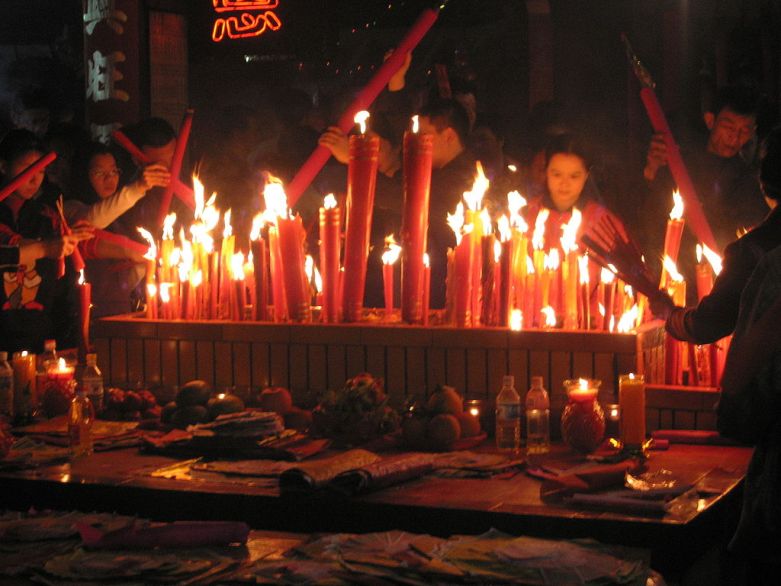
Chinese New Year’s Eve 2005, Meizhou, China, photo by Anthony Hartman
February 19-24, 2015, is the duration of this year’s Chinese New Year (Spring Festival) celebrations. Before the holiday is over, I’d like to share an interesting article on the Spring Festival designed to help anyone curious about the cultural significance of this most colorful of holidays. Among other things, you will read about fish, money-filled envelopes, the color yellow and door gods. Enjoy!
The following article was authored by and republished with the permission of Sean Upton-McLaughlin. Sean has lived and worked in Mainland China for six years. Through a strong command of the Chinese language and his experiences working with Chinese companies and executives, he has gained numerous insights into Chinese culture, society, behavior, and communication styles. For more of Sean’s writings on Chinese business and culture, please visit The China Culture Corner.
12 Important Symbols of the Chinese Spring Festival
 The Chinese New Year, or Spring Festival is the most important holiday in Mainland China and is also celebrated by millions of ethnic Chinese around the world. Despite modern commercialism, the Spring Festival remains primarily a family holiday, and an important time of reunion. While many Westerners may never have the chance to observe first-hand how the Chinese celebrate the festival in their own homes, every year Chinese cities and towns are filled with a multitude of decorations, all of which contain strong symbolism with regard to the Chinese Spring Festival, and what the Chinese people value at the start of a new year.I have put together a list of some of the key symbols and themes Westerners are likely to see around the time of the Chinese Spring Festival, along with short descriptions of their meanings and history. In learning about these symbols, Westerners will be able to understand how the Chinese celebrate this important festival. So the next time a Chinese friend or business partner asks “Do you know why we use XX during the Spring Festival?” you can give them a nice surprise!
The Chinese New Year, or Spring Festival is the most important holiday in Mainland China and is also celebrated by millions of ethnic Chinese around the world. Despite modern commercialism, the Spring Festival remains primarily a family holiday, and an important time of reunion. While many Westerners may never have the chance to observe first-hand how the Chinese celebrate the festival in their own homes, every year Chinese cities and towns are filled with a multitude of decorations, all of which contain strong symbolism with regard to the Chinese Spring Festival, and what the Chinese people value at the start of a new year.I have put together a list of some of the key symbols and themes Westerners are likely to see around the time of the Chinese Spring Festival, along with short descriptions of their meanings and history. In learning about these symbols, Westerners will be able to understand how the Chinese celebrate this important festival. So the next time a Chinese friend or business partner asks “Do you know why we use XX during the Spring Festival?” you can give them a nice surprise!
 The Color Red: in Chinese culture the color red is closely associated with good fortune and happiness. It is a common theme throughout the Chinese Spring Festival, and many items are created partly or entirely in red colors, including clothing, firecrackers, and many types of decorations. In China, the importance of the color red is also linked to a beast called a “Nián (年)” which is said to have terrorized a village in ancient China on the first day of every New Year. The villagers eventually realized that the Nián was scared of the color red, and began using the color to decorate their houses when preparing for the coming of the new year. In addition to its usage during the Spring Festival, the color red is also commonly used in weddings, and when a new business opens.
The Color Red: in Chinese culture the color red is closely associated with good fortune and happiness. It is a common theme throughout the Chinese Spring Festival, and many items are created partly or entirely in red colors, including clothing, firecrackers, and many types of decorations. In China, the importance of the color red is also linked to a beast called a “Nián (年)” which is said to have terrorized a village in ancient China on the first day of every New Year. The villagers eventually realized that the Nián was scared of the color red, and began using the color to decorate their houses when preparing for the coming of the new year. In addition to its usage during the Spring Festival, the color red is also commonly used in weddings, and when a new business opens. The Color Yellow: the color yellow was traditionally the symbol of the Chinese emperor, and even in modern society can be seen as denoting a higher status. While yellow is often viewed as a symbol of cowardice in Western societies, this bias does not exist in China as the color is a symbol of heroism. In China, the color yellow is also seen as symbolizing good luck. However, the color yellow should be used carefully by those not familiar with Chinese culture as in some circumstances it can refer to pornography or lewd behavior.
The Color Yellow: the color yellow was traditionally the symbol of the Chinese emperor, and even in modern society can be seen as denoting a higher status. While yellow is often viewed as a symbol of cowardice in Western societies, this bias does not exist in China as the color is a symbol of heroism. In China, the color yellow is also seen as symbolizing good luck. However, the color yellow should be used carefully by those not familiar with Chinese culture as in some circumstances it can refer to pornography or lewd behavior.
For the remaining 10 symbols, please visit 12 Important Symbols of the Chinese Spring Festival. 🙂
Till next time,
Ramona (林明心)
PS
By the way, for some of my own personal experiences of Spring Festival in China, please see my last blog post Spring Festival In China, a Personal Story.






I didn’t know that the color yellow meant all that. I think I might be using it as a pop of color when we move.
“Good luck,” yes, and something that Sean did not mention is royalty. Yellow was a color associated with the emperor and his family in the old days. It was grounds to be executed if a commoner dared wear the royal color! No more emperors, so you’re safe!
I love reading about the symbolism of things we take for granted (accept at face value) in western society. I like the idea of yellow as being a positive force too as it’s such a warm color and associated with the sun.
I like yellow too. Of the remaining 10 symbols I think my favorites are “fu” (very different meaning in Chinese!) and the kitchen god. 😉 12 Important Symbols of the Chinese Spring Festival
I love yellow as well. Yellow is warm, bright colour and always associated with the sun.
Thanks for your comment, Safari.
I learn so much every single time I read one of your posts. I love the color red. It’s one of my favorite colors. Good fortune and happiness? I’ll take it.
Thanks, Lois. 🙂
I’ve always loved that in Chinese culture, the colour red is regarded with such reverence. Even brides dress in red instead of white! Now that’s just good common sense. As for yellow, how ironic that it means the exact opposite of what it does in the western world. There’s so much depth and meaning to Chinese values with many layers of symbolism. A great, ancient culture – yet so very relevant, always.
Love your comment, Krystyna, and I agree with you. 🙂 The ancient wisdom of China is timeless. If people were to learn from it, the world would be an immensely more healthy place. Thank you for taking the time to write.